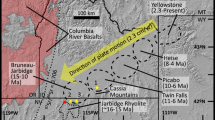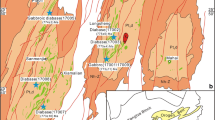Abstract
Large volume (100–1000 km3), widespread rhyolitic ignimbrites are the main products of the Taupo volcanic zone (TVZ) of New Zealand, one of the most active silicic volcanic regions on Earth. Several factors have made correlation and the eruptive history of the ignimbrites difficult to resolve, including limited exposure and chronological data, broadly similar lithologies and the lack of stratigraphic successions visible in the field. We have used the isothermal plateau fission track (ITPFT) method on glass shards from the non-welded basal zones to obtain new eruption ages for the widespread units: Ongatiti (1.25±0.12 Ma), Whakamaru group (0.34±0.03 Ma), Matahina (0.34±0.02 Ma), Chimp (0.33±0.02 Ma), Kaingaroa (0.31±0.01 Ma) and Mamaku (0.23±0.01 Ma) ignimbrites. These glasses show little evidence of geochemical alteration and allow the units to be fingerprinted for correlation. The glass ages we have obtained for the late Quaternary units provide an independent check on chronological data obtained from phenocryst phases. The ITPFT method is a useful dating approach for sanidine-poor eruptives which limit the application of 40Ar/39Ar. Errors as limited as 10–30 ka can be obtained from the weighted mean of several age determinations. The thermoremanent magnetic (TRM) direction recorded in the units provides a means of correlation over a wide area of the TVZ, because each ignimbrite can be distinguished by its unique record of palaeosecular variation. These data indicate that the four separately mapped members of the Whakamaru group represent the same phase of activity, occurring within a period of 100 years. The TRM data indicate that the widespread Ahuroa ignimbrite erupted during an excursion in Earth's magnetic field, perhaps associated with the Cobb Mountain subchron (ca. 1.2 Ma). The youngest widespread welded unit, Mamaku ignimbrite (ca. 0.23 Ma), also erupted during an excursion and may represent a southern hemisphere record of the Pringle Falls geomagnetic episode found in the western United States. The palaeomagnetic and ITPFT data for the widespread late Quaternary ignimbrites suggest a major period of caldera formation at 0.34–0.30 Ma. This interval represents the eruption of multiple units from the Whakamaru caldera, followed by the formation of the Okataina and Reporoa calderas in rapid succession.
Similar content being viewed by others
Author information
Authors and Affiliations
Rights and permissions
About this article
Cite this article
Black, T., Shane, P., Westgate, J. et al. Chronological and palaeomagnetic constraints on widespread welded ignimbrites of the Taupo volcanic zone, New Zealand. Bull Volcanol 58, 226–238 (1996). https://doi.org/10.1007/s004450050137
Received:
Accepted:
Published:
Issue Date:
DOI: https://doi.org/10.1007/s004450050137




